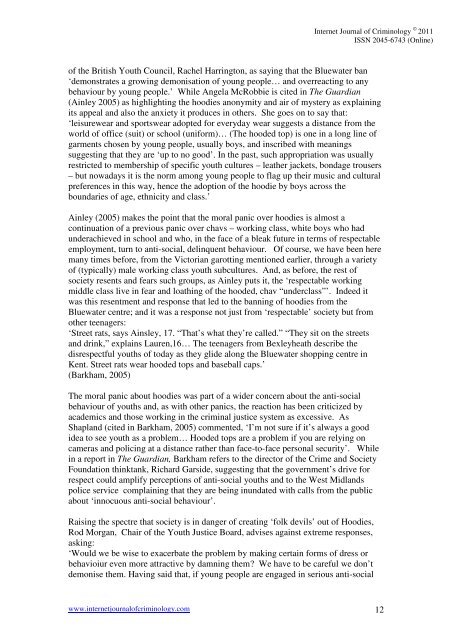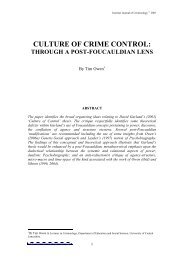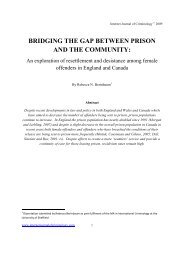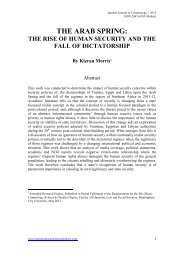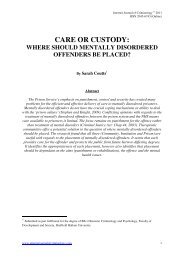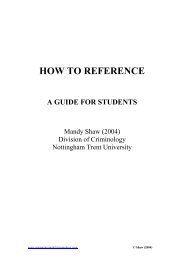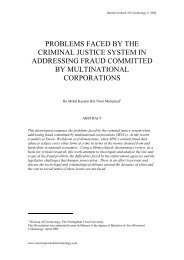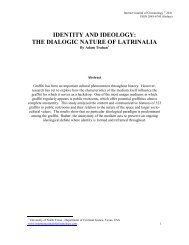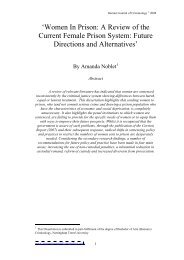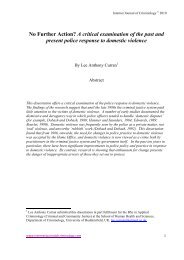moral panics and the british media - Internet Journal of Criminology
moral panics and the british media - Internet Journal of Criminology
moral panics and the british media - Internet Journal of Criminology
You also want an ePaper? Increase the reach of your titles
YUMPU automatically turns print PDFs into web optimized ePapers that Google loves.
<strong>Internet</strong> <strong>Journal</strong> <strong>of</strong> <strong>Criminology</strong> © 2011<br />
ISSN 2045-6743 (Online)<br />
<strong>of</strong> <strong>the</strong> British Youth Council, Rachel Harrington, as saying that <strong>the</strong> Bluewater ban<br />
‘demonstrates a growing demonisation <strong>of</strong> young people… <strong>and</strong> overreacting to any<br />
behaviour by young people.’ While Angela McRobbie is cited in The Guardian<br />
(Ainley 2005) as highlighting <strong>the</strong> hoodies anonymity <strong>and</strong> air <strong>of</strong> mystery as explaining<br />
its appeal <strong>and</strong> also <strong>the</strong> anxiety it produces in o<strong>the</strong>rs. She goes on to say that:<br />
‘leisurewear <strong>and</strong> sportswear adopted for everyday wear suggests a distance from <strong>the</strong><br />
world <strong>of</strong> <strong>of</strong>fice (suit) or school (uniform)… (The hooded top) is one in a long line <strong>of</strong><br />
garments chosen by young people, usually boys, <strong>and</strong> inscribed with meanings<br />
suggesting that <strong>the</strong>y are ‘up to no good’. In <strong>the</strong> past, such appropriation was usually<br />
restricted to membership <strong>of</strong> specific youth cultures – lea<strong>the</strong>r jackets, bondage trousers<br />
– but nowadays it is <strong>the</strong> norm among young people to flag up <strong>the</strong>ir music <strong>and</strong> cultural<br />
preferences in this way, hence <strong>the</strong> adoption <strong>of</strong> <strong>the</strong> hoodie by boys across <strong>the</strong><br />
boundaries <strong>of</strong> age, ethnicity <strong>and</strong> class.’<br />
Ainley (2005) makes <strong>the</strong> point that <strong>the</strong> <strong>moral</strong> panic over hoodies is almost a<br />
continuation <strong>of</strong> a previous panic over chavs – working class, white boys who had<br />
underachieved in school <strong>and</strong> who, in <strong>the</strong> face <strong>of</strong> a bleak future in terms <strong>of</strong> respectable<br />
employment, turn to anti-social, delinquent behaviour. Of course, we have been here<br />
many times before, from <strong>the</strong> Victorian garotting mentioned earlier, through a variety<br />
<strong>of</strong> (typically) male working class youth subcultures. And, as before, <strong>the</strong> rest <strong>of</strong><br />
society resents <strong>and</strong> fears such groups, as Ainley puts it, <strong>the</strong> ‘respectable working<br />
middle class live in fear <strong>and</strong> loathing <strong>of</strong> <strong>the</strong> hooded, chav “underclass”’. Indeed it<br />
was this resentment <strong>and</strong> response that led to <strong>the</strong> banning <strong>of</strong> hoodies from <strong>the</strong><br />
Bluewater centre; <strong>and</strong> it was a response not just from ‘respectable’ society but from<br />
o<strong>the</strong>r teenagers:<br />
‘Street rats, says Ainsley, 17. “That’s what <strong>the</strong>y’re called.” “They sit on <strong>the</strong> streets<br />
<strong>and</strong> drink,” explains Lauren,16… The teenagers from Bexleyheath describe <strong>the</strong><br />
disrespectful youths <strong>of</strong> today as <strong>the</strong>y glide along <strong>the</strong> Bluewater shopping centre in<br />
Kent. Street rats wear hooded tops <strong>and</strong> baseball caps.’<br />
(Barkham, 2005)<br />
The <strong>moral</strong> panic about hoodies was part <strong>of</strong> a wider concern about <strong>the</strong> anti-social<br />
behaviour <strong>of</strong> youths <strong>and</strong>, as with o<strong>the</strong>r <strong>panics</strong>, <strong>the</strong> reaction has been criticized by<br />
academics <strong>and</strong> those working in <strong>the</strong> criminal justice system as excessive. As<br />
Shapl<strong>and</strong> (cited in Barkham, 2005) commented, ‘I’m not sure if it’s always a good<br />
idea to see youth as a problem… Hooded tops are a problem if you are relying on<br />
cameras <strong>and</strong> policing at a distance ra<strong>the</strong>r than face-to-face personal security’. While<br />
in a report in The Guardian, Barkham refers to <strong>the</strong> director <strong>of</strong> <strong>the</strong> Crime <strong>and</strong> Society<br />
Foundation thinktank, Richard Garside, suggesting that <strong>the</strong> government’s drive for<br />
respect could amplify perceptions <strong>of</strong> anti-social youths <strong>and</strong> to <strong>the</strong> West Midl<strong>and</strong>s<br />
police service complaining that <strong>the</strong>y are being inundated with calls from <strong>the</strong> public<br />
about ‘innocuous anti-social behaviour’.<br />
Raising <strong>the</strong> spectre that society is in danger <strong>of</strong> creating ‘folk devils’ out <strong>of</strong> Hoodies,<br />
Rod Morgan, Chair <strong>of</strong> <strong>the</strong> Youth Justice Board, advises against extreme responses,<br />
asking:<br />
‘Would we be wise to exacerbate <strong>the</strong> problem by making certain forms <strong>of</strong> dress or<br />
behavioiur even more attractive by damning <strong>the</strong>m? We have to be careful we don’t<br />
demonise <strong>the</strong>m. Having said that, if young people are engaged in serious anti-social<br />
www.internetjournal<strong>of</strong>criminology.com 12


